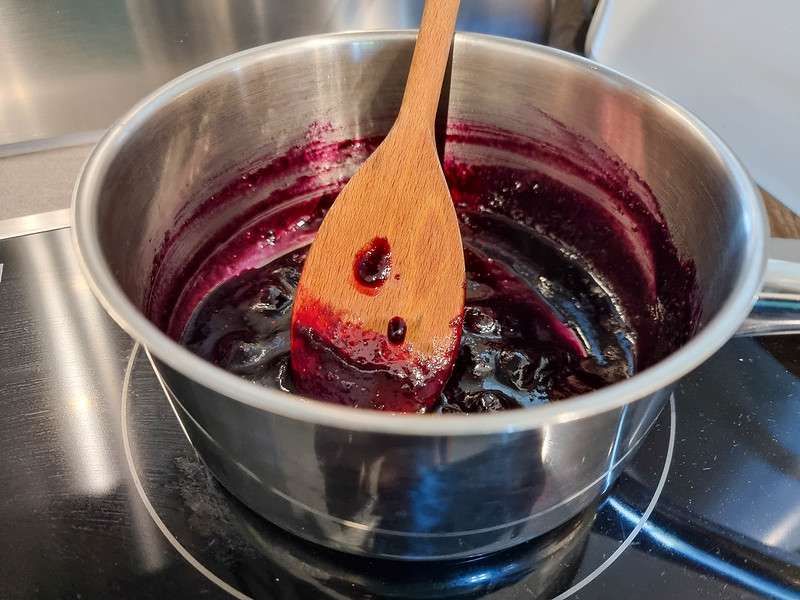Papanasi is one of my favourite Romanian desserts. They are also some of the most popular on the menus of the traditional Romanian restaurants around the country. Whilst making Romanian papanasi might seem complicated, you will be surprised to know that it is actually very, very easy. This papanasi recipe is decadent and delicious, and you will want to make it over and over again.
I remember the first time I had papanasi, and it’s one of my most cherished childhood memories. I was probably around 5 years old and I don’t remember much from that time of my life. But I do remember that warm summer evening, in my grandparents’ garden. It was the end of August, and we had just finished dinner. My grandpa disappeared into the kitchen and came back after a short while with these warm doughnut balls covered in sour cream and our homemade sour cherry jam, from the very tree above us that was providing shade for our table. It was the first and the last time I ever tried home cooked papanasi. My grandpa fell ill and passed away shortly after, and nobody else in my family ever cooked them again. I guess this is why this memory is so close to my heart, because I didn’t get to spend a lot of time with him.
Jump to RecipeThe Ingredients for This Papanasi Recipe

Yes, they look amazing and impressive, but papanasi are quite easy to make. You don’t need a lot of ingredients for them. The special ingredient that makes them fluffy on the inside is the cottage cheese.
I would highly recommend buying cottage cheese from the Romanian shop. This is because the English cottage cheese tends to be quite runny and has lots of liquid in it. Also, the one you can find in an English supermarket has a pearly texture, whilst the Romanian one is more like a paste. If you can’t find any (I couldn’t at the time I made this recipe), make sure to put the cottage cheese in a sieve and let it drain overnight.
How to Make Romanian Papanasi

Making papanasi doesn’t take a long time. Firstly, you have to mix the cottage cheese with the eggs, sugar, lemon zest and vanilla essence. Add the flour mixed with the baking powder and let it rest. You will produce a very sticky dough, hard to manoeuvre – but don’t worry, that is how it is supposed to be. It is important not to knead the dough too much, as this will release the starch in the flour, making the papanasi very hard.
In preparation of forming the rings and the ball shapes ready for frying, dust your hands with flour and you will be able to easily form the shapes. The papanasi will expand during frying, so don’t overcrowd the pan.
Because I baked this recipe at a friend’s house, I couldn’t find a Romanian shop in the area from where to buy a jar of sour cherry jam. As it is winter, I couldn’t even find cherries in the supermarket. The jam for this papanasi recipe has to be runny – again hard to find even in Big Tesco, so I just bought some blueberries and made my own whilst the dough was resting.
Recipe Notes and Tips

Romanian cooking is wholesome and full of flavour, and I want to help you create that. Here are some of the helpful recipe notes and tips that will help with this Romanian papanasi recipe.
– The dough will be sticky. It doesn’t need more flour just as long as you can knead it.
– Don’t over knead the dough. Just enough to be able to form a shape, before leaving it to rest. If you are using Romanian cottage cheese the dough will be much firmer than if you use the English pearled one.
– When you form the shape of the papanasi, dust your hands with flour. This way you will be able to work the dough easily.
– You can shallow fry the papanasi. I didn’t want to waste a lot of oil, so I used a shallow pan in which I put only two fingers of oil. When you shallow fry you need to pay attention so that the dough doesn’t stick to the bottom of the pan.
– This recipe traditionally uses sour cherry dulceata (runny jam). It is also good with blueberry jam. If you can’t find any runny jam in the stores, you can make your own by mixing equal quantities of fruits and sugar, with a touch of lemon juice.
– Serve the papanasi with a sour cream that has at least 18% fat. I noticed that Tesco’s own brand is a good alternative, even if it only has 16%.

Papanasi
Ingredients
- 400 grams Romanian cottage cheese
- 250 grams self raising flour
- 2 eggs
- zest from one lemon
- 1 pack vanilla
- a pinch of salt
- oil to fry
To serve:
- sour cream 18% fat
- 1 jar sour cherry jam runny jam, not preserve or marmelade
- icing sugar for decor
Instructions
- Put all the ingredients in a bowl and mix to form a dough. This will have a sticky consistency.
- Let it rest at room temperature for half an hour
- Form the dough rings and balls by dusting your hand with flour. Shape them in your hands.
- Put enough oil in a shallow pan and let it come to a high temperature.
- Drop the rings first in the oil, making sure not to overcrowds the pan. Fry for 2 minutes on each side, until they become golden brown. Take out of the pan and put on a plate covered with kitchen towel, to drain the extra oil.
- Do the same with the balls.
- Serve hot, two on a plate, covered with sour cream, sour cherry jam and icing sugar. Enjoy!
FAQ

Can you make them in advance to eat later?
Yes, but they are much better when you eat them straight after you’ve cooked them, warm. They don’t reheat very well in the microwave and you risk the dough getting hard and chewy instead of fluffy and soft.
How do I store the Romanian Papanasi?
I don’t recommend storing the papanasi. But, if you make too many, you can store them in an airtight container.
For more traditional Romanian desserts check out:
– How to make Romanian Diplomat Cake
– How to make Romanian Walnut Cake
– How to make Romanian Raisin Cookies
Like it? Pin it!





